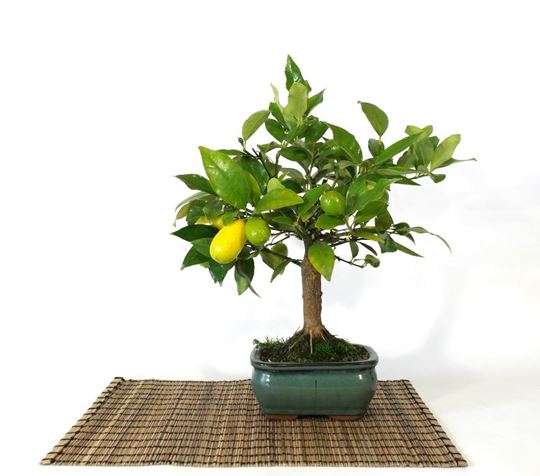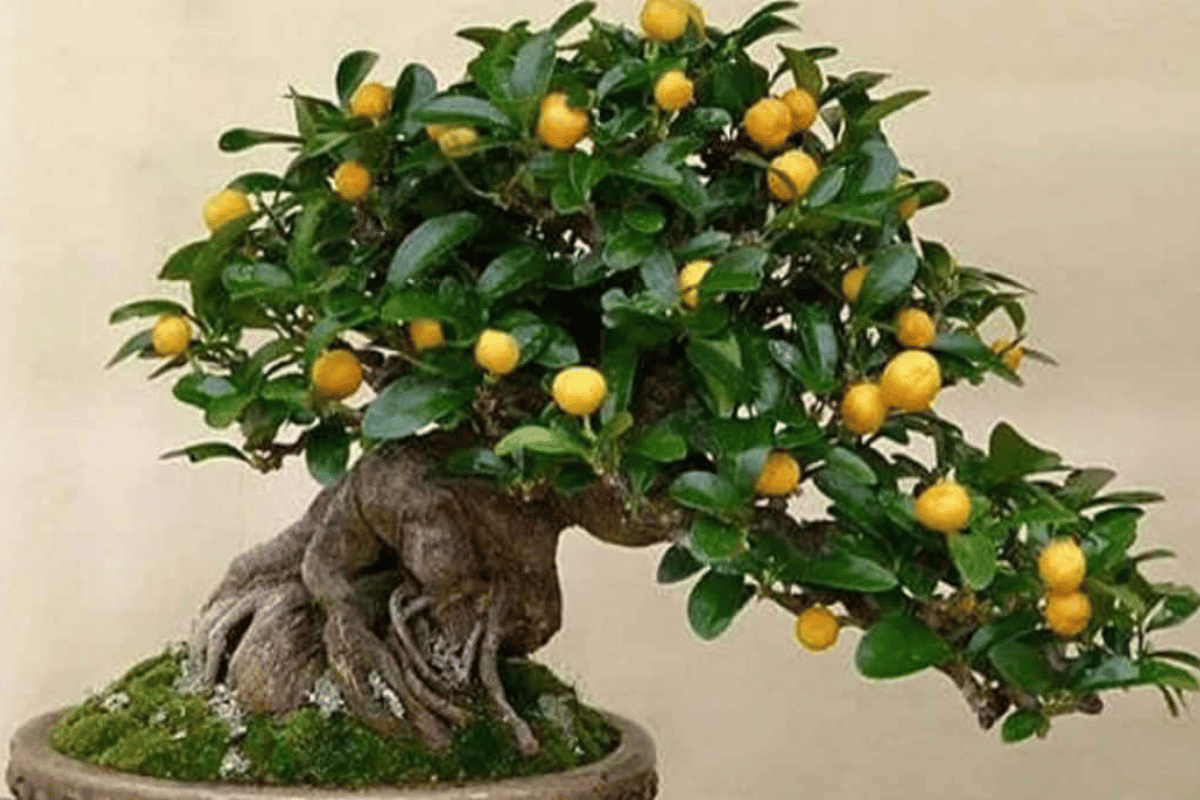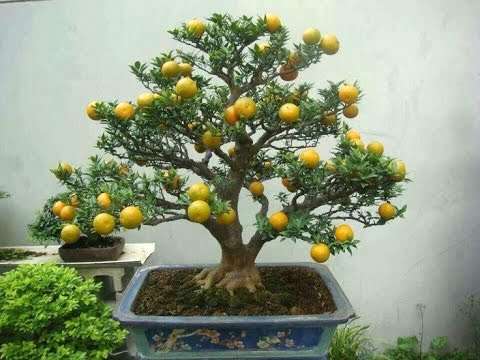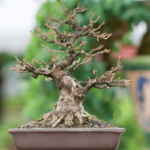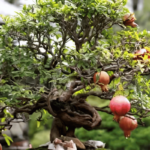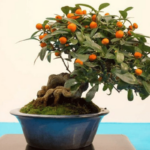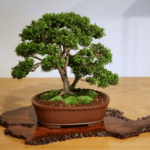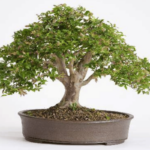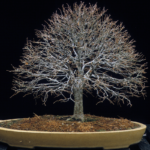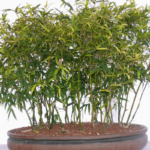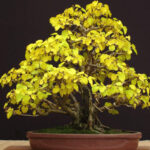Did you know that it’s possible to create a lemon bonsai?
Lemons, just like oranges, fall into the category of citrus plants, and some of these plants can be turned into bonsais.
There are several lemon species that can become bonsai, for example:
- Sicilian
- Clove (also known as pink lemon)
- Galego
- Tahiti
As we’ve already discussed orange bonsais, today let’s talk about lemon bonsais.
Curiosities
The vast majority of lemon species used for bonsai are native to China.
Their leaves are dark green and have a very noticeable shine.
Their flowers can be:
- White
- Yellow
- Orange
These flowers, in most cases, are fragrant and after some time, are replaced by fruits.
The lemons produced by the lemon bonsai depend on its cultivation and the size of the plant.
If you have children at home, be careful, as these bonsais can have thorns.
Below, we’ll learn a bit more about how to cultivate them.
How to Cultivate Lemon Bonsai
Just like the regular-sized lemon, cultivating this plant is extremely simple.
The only difficulty you’ll encounter is if you live in a colder region because lemons prefer a warm climate.
Below, we will address the main topics you need to master to have a lemon bonsai:
- How to make a lemon bonsai from seeds
- Temperature
- How to water
- Fertilization
- Pruning and wiring
- Planting and repotting
- How to prevent pests and diseases
Follow the tips below to cultivate your lemon bonsai.
How to make a lemon bonsai from seeds
First, you need to learn how to make lemon seedlings:
- Choose one of the lemon species mentioned at the beginning of this text
- Remove and clean the seeds
- Select a shallow container and place the planting substrate.
- Plant the seeds at a depth of about 2cm
- Place the container in a well-lit location where it receives adequate sunlight, and keep the soil moist.
- To keep the soil moist, follow this tip: when the top of the soil starts to dry out, it’s time to water.
- After 2 or 3 weeks, the seeds will begin to germinate
- When the seedlings start developing leaves, you can select the ones that will become a bonsai
- Replant the chosen seedlings into a larger pot
The second step is to wait for your seedlings to be about 1 year old to start the process of turning them into a bonsai.
To perform this procedure, follow the step-by-step instructions in the video below:
Some important observations:
- It’s unlikely that your lemon bonsai will produce fruits before reaching 5 years old, as this process takes time.
- When planting the seeds, it’s recommended to leave space between them to allow healthy growth. This will also allow you to choose the best seedling to create your bonsai.
- Although it’s a time-consuming process, cultivating a lemon bonsai from seeds can be an economical option to have a beautiful bonsai specimen at home.
Temperature
As previously mentioned, lemons prefer warmer temperatures, so you should grow them outdoors in direct sunlight.
They should only be brought indoors if you live in a region with colder temperatures.
In moderate climates, this bonsai should be kept indoors during the colder months.
Watering
Watering is another extremely simple factor when it comes to taking care of a lemon bonsai.
The first thing you should know is that they don’t like to be waterlogged, so keep that in mind.
They don’t like constantly wet soil.
It’s recommended to water, wait for the soil to dry for a short period of time, and then water again.
During watering, thoroughly wet the bonsai.
Important observations:
- As mentioned above, during seedling generation, the soil should remain moist; however, during the adult phase of your plant, a short period with dry soil is recommended.
- The frequency of watering in the summer is higher than in the winter.
Fertilizing
Fertilizing is necessary for these plants, as they don’t have a natural source of nutrients.
For example, in nature, a lemon can feed on the decomposition of leaves and animals near its roots, but in a pot, this is no longer possible.
It’s recommended that you choose a fertilizer specially designed for citrus plants.
Potassium-rich fertilizers can increase the roots’ growth and strengthen the bonsai’s wood.
During the summer months, it’s advised to use only organic fertilizers and wait for the fruits to fall from the lemon tree before fertilizing.
Pruning and Wiring
Pruning should be done regularly to achieve good branching, and lemon bonsai is no exception.
As pruning is a slightly more complex process to explain in words, watch the video below:
As for wiring, it can be done throughout the year, just be cautious not to cut the bark.
Planting and Repotting
Lemon bonsai can be propagated in two ways:
- From seeds
- From cuttings
As for repotting, it should be done every 2 or 3 years, always trimming the roots.
When putting your lemon bonsai back into the pot, remember that they prefer slightly acidic soil.
Pests and Diseases
Just like any other plant, your bonsais can be attacked by pests and diseases.
In lemon bonsais, the main pests that attack them are:
- Mites
- Scales
- Insects (in general)
- Leaf miners
- Mealybugs
- Red spider mites
For this reason, I recommend that you read the article on pests and diseases in bonsais, where you’ll find several tips on how to combat and prevent the majority of these problems.
Conclusion
I hope you’ve learned a lot about cultivating lemon bonsais. Now it’s up to you; practice what you’ve learned from this article with your plants.
And if you’d like to know more, here are 3 interesting facts:
- This bonsai follows the hokidachi style.
- The Meyer lemon can be a great bonsai option for those living in colder areas.
- We have several other articles that can help you grow bonsai. For example, our guides on buxus bonsai, jabuticaba bonsai, pomegranate bonsai, mulberry bonsai, etc.
Liked this article? Then share it on your social networks.

